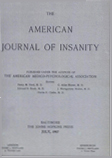SIX YEARS EXPERIENCE WITH NARCOSIS THERAPY IN PSYCHIATRY
Abstract
1. From the studies in the past six years regarding the physiological reactions which occur under the influence of sodium amytal we can conclude that the following definite changes at the physiological level take place: (a) dilation of cerebral blood vessels, (b) lowered blood pressure, (c) marked lowering of oxygen consumption rate, (d) decrease of oxygen and dextrose "uptake" by the brain tissue, (e) a change from abnormal to normal in certain neuromuscular responses as measured by the chronaxia method. The conclusion seems to be that the drug acts upon the hypothalamus affecting the sleep and metabolic centers as well as upon the higher psychic functions.
2. On the psychological level the narcotic agent promotes contact, breaks through psychotic resistance, renders the patient more accessible to psychotherapeutic endeavors and seems to enable the patient to reveal hidden sources of conflict which in the non-narcotic state are not available either to the patient or to the physician. It transports the depressed, the agitated and involutional melancholia patient into a calm serenity which offers him at least temporary relief from his torments. Many depressions express optimism (for the first time since the onset of illness) after the first few days of treatment. There appears to be some degree of neurophysiological readjustment paralleling, and possibly constructively influencing, the psychological changes.
3. There seems to be a general feeling among those who have used the narcosis method that results in schizophrenics are not altogether encouraging. Our results show approximately a 22 percent recovery rate which cannot be overlooked. It is true that these results do not compare very favorably with the high percentage of recoveries reported by workers with the insulin treatment in schizophrenia. Nevertheless, in many instances it has been successful.
4. The more experience we accumulate in the management of patients under narcosis therapy, the less standardized the treatment becomes. We are less likely to be dogmatic about dosage and indications for changing the course of the treatment. There is a tendency to judge trends of improvement on a basis of day to day observation and to use modifications of the treatment especially in the involutional psychoses.
5. The method is not necessarily a physical hazard if patients are chosen with care. In fact, many patients show striking physical improvement in skin color and tone, disappearance of acneform eruptions, and in two instances a pre-existing colitis entirely disappeared. The complications have, in general, not been severe in our experience. There have been no fatalities and we can say with assurance that no discoverable systemic damage has been done. We have found no need for the administration of glucose and insulin inasmuch as under sodium amytal narcosis severe ketosis does not occur.
6. The greatest therapeutic usefulness of the narcosis method is apparently in the manic-depressive group, especially in the acute manic attack. Apropos of its usefulness in interrupting the course of a manic episode, the following case will be illuminating:
CASE 86.—College girl of 19. Father manic-depressive, circular. Suddently developed overactivity, flight of ideas, distractibility. She was placed in the college infirmary the first day of the illness, given sodium amytal at once, moved in semi-conscious state to hospital where narcosis was given. After first seven days emerged with marked manic symptoms. Narcosis was resumed for five days. The patient emerged remarkably improved and continued with rapid, uninterrupted gains. Returned to college and finished her junior year creditably with her class. In this instance the patient was spared the deteriorating experience of an attack of full blown acute mania; the nature of her illness was not known by fellow students. Remains well one year after discharge from the hospital.
7. The conclusions of some of the other physicians who have had experience with this technique are illuminating. Bond 81 has stated that narcosis should be tried in almost every case of acute mania. He believes that acute mania, if it goes full force and untrammeled represents a deteriorating experience which permanently damages the psychic resistance of the patient. The precipitation of the patient into a state of illness where intimate bedside nursing is imperative has a powerful psychological contribution to make to the other therapeutic mechanisms of the narcosis treatment. Strecker 32 believes that the results from the narcosis therapy are significant enough to justify its continuation as a standard method of treatment. He states, "In my experience, the patients particularly benefited were those in the acute manic phase of manic depressive psychoses but any of the manifestations of the manic phase seem to be favorable for treatment. In a number of other psychotic and neurotic states, the therapy seems to be helpful. For example, in the intense agitation of involutional melancholia a modification of deep narcosis therapy has been productive of surprisingly good results." Appel 33 states that the best results seem to be obtained in young, intelligent manics. It is also useful to tide over acute schizophrenic episodes and is of great practical use in many instances in that it obviates the necessity for commitment. It is also useful in relieving the agitation and tension in certain involutional psychoses.
Access content
To read the fulltext, please use one of the options below to sign in or purchase access.- Personal login
- Institutional Login
- Sign in via OpenAthens
- Register for access
-
Please login/register if you wish to pair your device and check access availability.
Not a subscriber?
PsychiatryOnline subscription options offer access to the DSM-5 library, books, journals, CME, and patient resources. This all-in-one virtual library provides psychiatrists and mental health professionals with key resources for diagnosis, treatment, research, and professional development.
Need more help? PsychiatryOnline Customer Service may be reached by emailing [email protected] or by calling 800-368-5777 (in the U.S.) or 703-907-7322 (outside the U.S.).



